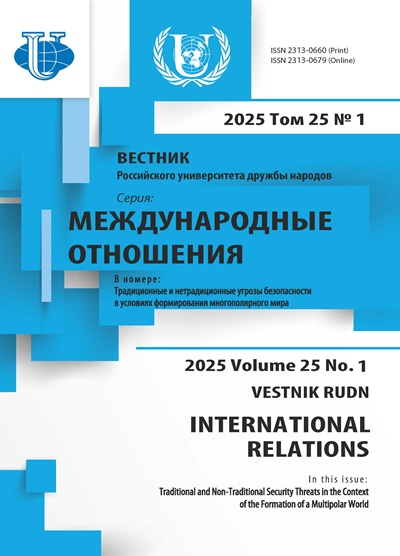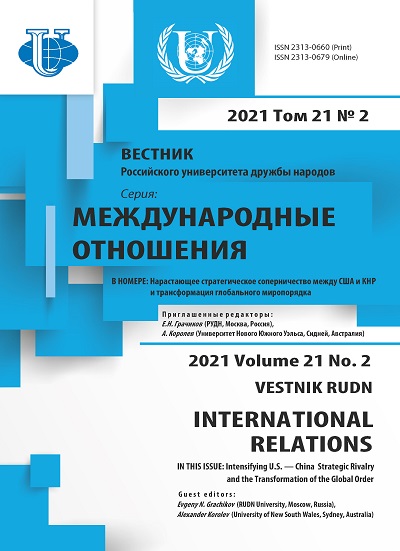Comparative Analysis of American NGOs in China and Chinese NGOs in the U.S.
- Authors: Kharkevich M.V.1, Pisarev I.I.2, Cheresov V.S.2, Novogradskaya M.O.2
-
Affiliations:
- MGIMO University
- Far Eastern Federal University
- Issue: Vol 21, No 2 (2021): Intensifying U.S. — Сhina Strategic Rivalry and the Transformation of the Global Order
- Pages: 350-371
- Section: PEACE AND SECURITY
- URL: https://journals.rudn.ru/international-relations/article/view/26782
- DOI: https://doi.org/10.22363/2313-0660-2021-21-2-350-371
Cite item
Full Text
Abstract
This article analyzes the activities of American non-governmental organizations (NGOs) in China and Chinese NGOs in the United States in the context of global competition between the United States and China for the leadership in the future model of the world order. In International Relations theory, especially in its theoretical paradigm of realism, the consideration of states as actors in international relations dominates scholarship. However, in recent decades it has become apparent that researchers have a significant interest in non-state actors, such as interest groups and NGOs, and their impact on international relations. NGOs in China and the United States have different historical backgrounds, environments, and government institutions in different ways. Still, but in terms of comparative analysis they represent comparable categories. The analysis offered in this study shows that, firstly, despite the strict regulation of the activities of NGOs in place in China, American NGOs have more opportunities to work in this environment than Chinese NGOs do in the United States, where the situation for their activities is apparently more favorable. Secondly, despite the advantages that partnerships provide, neither American nor Chinese NGOs form partnership networks and therefore, lose momentum for their own development. Thirdly, although the conditions for their activities differ in both countries, American and Chinese NGOs have equal opportunities to pursue their goals. Finally, American NGOs in China are less dependent on their government than Chinese NGOs in the United States are on the Chinese government. The study is comparative and takes as its units of analysis Chinese NGOs in the United States and American NGOs in China. Developments in the field of interest group politics serve as the theoretical framework for this research. The investigation uses methods of comparative quantitative analysis and social network analysis, while the interdisciplinary nature of the methods allow them to take advantage of the analytical capabilities of Comparative Political Science, Interest Group Politics, and International Relations.
Full Text
Table 1. Differences between NGOs and GONGOs
Comparison criterion | NGOs | GONGOs |
Material basis of activity | Public or private donations, fundraising | Government sponsored |
Public perception of the legitimacy of an activity | Statements, actions and interpretations are seen as legitimate by the public | Statements, actions and interpretations can be viewed as compromised by the public given their closeness to government (notably the case in liberal democracies) |
Geographical representation of activities | Local, Regional, National and/or International Power | |
Value orientation | Reflect individual NGO values and beliefs | Reflect government values and beliefs |
Source: [Hasmath, Hildebrandt, Hsu 2019].
Fig. 1. Map of American NPOs in the PRC and their network of partnerships
Source: compiled by the authors using data of: Registered Foreign NGO Representative Offices Interactive Map and Filterable Table // China NGO Project.
URL: https://www.chinafile.com/ngo/registered-foreign-ngo-offices-map-full-screen (accessed: 29.01.2021).
Fig. 2. Map of Chinese NPOs in the USA and their network of partnerships
Source: compiled by the authors using data of: Endorsing Organizations // United Chinese Americans.
URL: https://ucausa.org/co-signers-of-uca/ (accessed: 29.01.2021).
About the authors
Maxim Vladimirovich Kharkevich
MGIMO University
Author for correspondence.
Email: am.kharkevich@inno.mgimo.ru
ORCID iD: 0000-0001-9476-9694
PhD in Political Science, Associate Professor, Department of Governance and Politics, Deputy Director of the Department of Scientific Policy, MGIMO University, Editor-in-Chief, MGIMO Review of International Relations
Moscow, Russian FederationIvan Ivanovich Pisarev
Far Eastern Federal University
Email: pinoy@mail.ru
ORCID iD: 0000-0002-0491-9503
Faculty Member, Department of Pacific Asia of the Institute of Oriental Studies - School of Regional and International Studies
Vladivostok, Russian FederationVsevolod Sergeyevich Cheresov
Far Eastern Federal University
Email: mr.cheresov99@mail.ru
Student, Department of Pacific Asia of the Institute of Oriental Studies - School of Regional and International Studies
Vladivostok, Russian FederationMarina Olegovna Novogradskaya
Far Eastern Federal University
Email: novogradskaya2000@gmail.com
Student, Department of Pacific Asia of the Institute of Oriental Studies - School of Regional and International Studies
Vladivostok, Russian FederationReferences
- Agapov, I.O. (2015). American model of legal regulation of lobbying. Actual Problems of Russian Law, (10), 178-185. (In Russian).
- Gayeva, A.S. (2015). Multicultural policy of the United States of America. Nauchno-Analiticheskii Zhurnal Obozrevatel’ - Observer, (2), 90-96. (In Russian).
- Gamza, L.A. (2020). Technological confrontation between the US and China in the Asia Pacific Region. Russia and the Pacific, (3), 110-133. (In Russian). https://doi.org/10.24411/1026-8804-2020-10038
- Kremyanskaya, E.A. (2014). Legal aspects of regulating lobbying in the United States of America and Canada. MGIMO Review of International Relations, (2), 161-168. (In Russian).
- Newhouse, J. (2009). Diplomacy, Inc. Russia in Global Affairs, 7(3), 108-126. (In Russian).
- Semenov, A.A. (2017). Classification of Non-Governmental Organizations in the PRC. Tomsk State University Journal of Philosophy, Sociology and Political Science, (37), 270-279. (In Russian). https://doi.org/10.17223/1998863X/37/27
- Baskin, D. (1970). American pluralism: Theory, practice, and ideology. The Journal of Politics, 32(1), 71-95. https://doi.org/10.2307/2128865
- Bentley, A.F. (1908). The process of government: A study of social pressures. Chicago: University of Chicago Press.
- Bouwen, P. (2002). Corporate lobbying in the European Union: The logic of access. Journal of European Public Policy, 9(3), 365-390. https://doi.org/10.1080/13501760210138796
- Clemens, E.S. (2006). The constitution of citizens: Political theories of nonprofit organizations. In W.W. Powell & R. Steinberg (Eds.), The nonprofit sector: A research handbook (pp. 207-220). Yale University Press.
- Dahl, R.A. (1961). Who governs? Power and democracy in an American city. New Haven, US: Yale University Press.
- Feng, C. (2017). The NGO law in China and its impact on overseas funded NGOs. Cosmopolitan Civil Societies: An Interdisciplinary Journal, 9(3), 96-105. https://doi.org/10.5130/ccs.v9i3.5601
- Hall, P.D. (2016). Historical perspectives on nonprofit organizations in the United States. In D.O. Renz & R.D. Herman (Eds.), The Jossey-Bass handbook of nonprofit leadership and management (pp. 3-33). Hoboken, New Jersey: John Wiley & Sons. https://doi.org/10.1002/9781119176558.ch1
- Hasmath, R., Hildebrandt, T., & Hsu, J.Y.J. (2019). Conceptualizing government-organized non-governmental organizations. Journal of Civil Society, 15(3), 267-284. https://doi.org/10.1080/17448689.2019.1632549
- Hsia, R.Y.-J., & White, L.T. (2002). Working amid corporatism and confusion: Foreign NGOs in China. Nonprofit and Voluntary Sector Quarterly, 31(3), 329-351. https://doi.org/10.1177/0899764002313002
- Hsu, J.Y.J., & Hasmath, R. (2014). The local corporatist state and NGO relations in China. Journal of Contemporary China, 23(87), 516-534. https://doi.org/10.1080/10670564.2013.843929
- Hsu, J.Y.J., Hsu, C.L., & Hasmath, R. (2017). NGO strategies in an authoritarian context, and their implications for citizenship: The case of the People’s Republic of China. Voluntas: International Journal of Voluntary and Nonprofit Organizations, 28(3), 1157-1179. https://doi.org/10.1007/s11266-016-9806-0
- Jie, C. (2006). The NGO community in China. Expanding linkages with transnational civil society and their democratic implications. China Perspectives, (68), 29-40. https://doi.org/10.4000/chinaperspectives.3083
- Jing, Y. (2015). Between control and empowerment: Governmental strategies towards the development of the non-profit sector in China. Asian Studies Review, 39(4), 589-608. https://doi.org/10.1080/10357823.2015.1090394
- Lowery, D. (2007). Why do organized interests lobby? A multi-goal, multi-context theory of lobbying. Polity, 39(1), 29-54. https://doi.org/10.1057/palgrave.polity.2300077
- McGlinchey, S. (Eds.). (2017). International relations. Bristol, England: E-International Relations Publishing.
- Mills, C.W. (1956). The power elite. Oxford: Oxford University Press.
- Olson, M. (1965). The logic of collective action: Public goods and the theory of groups. Harvard: Harvard University Press.
- Popović, E. (2017). Lobbying practices of citizens’ groups in China. SAGE Open, 7(2), 1-9. https://doi.org/10.1177/2158244017713554
- Schmitter, P.C., & Streeck, W. (1981). The organization of business interests: a research design to study the associative action of business in the advanced industrial societies of Western Europe. Berlin: Wissenschaftszentrum Berlin.
- Truman, D.B. (1951). The governmental process. Political interests and public opinion. New York: Alfred A. Knopf.
- Whiting, S.H. (1991). The politics of NGO development in China. Voluntas: International Journal of Voluntary and Nonprofit Organizations, 2(2), 16-48. https://doi.org/10.1007/BF01398669













